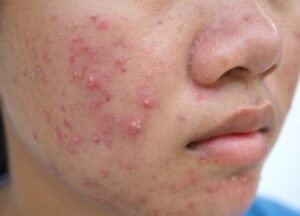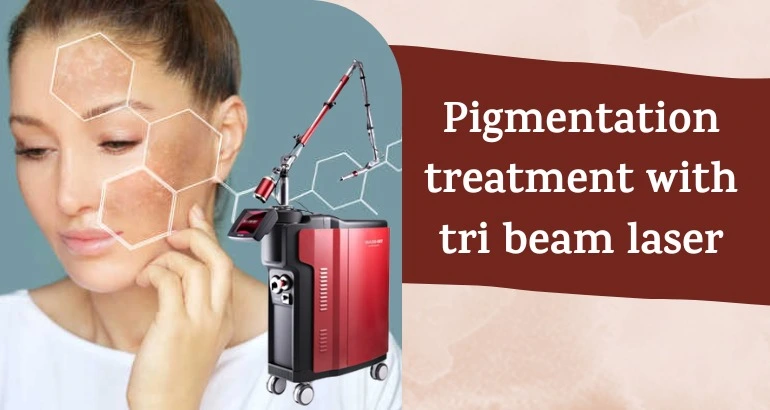Introduction:
Cystic acne is a severe and often painful form of acne that can leave lasting scars if not properly treated.
In this blog post, Dr. Pallavi Sule, a renowned dermatologist specializing in acne treatments in Powai, Mumbai, will shed light on the causes, symptoms, and available treatment options for cystic acne.
Dr. Pallavi Sule also offers the best acne scar treatments in Powai, Mumbai to help patients regain smooth and healthy skin.
What is Cystic Acne?

Cystic acne is a type of acne that occurs when the pores become clogged with excess oil, dead skin cells, and bacteria. Unlike regular acne, cystic acne involves deep, inflamed lesions that often leave behind scars. It is important to understand the difference between cystic acne and other forms of acne to effectively manage the condition.
Causes of Cystic Acne
- Hormonal Imbalances: Fluctuations in hormone levels, especially during puberty, pregnancy, or hormonal disorders, can contribute to the development of cystic acne.
- Genetic Predisposition: Family history of acne can increase the likelihood of developing cystic acne.
- Excess Sebum Production: Overactive sebaceous glands produce more oil, leading to clogged pores and acne formation.
- Bacterial Infections: Propionibacterium acnes, a bacteria commonly found on the skin, can multiply and cause inflammation and infection within the pores.
- Inflammation and Clogged Pores: Inflammatory responses to bacteria and excessive oil production can lead to the formation of painful cysts.
- Dietary Factors and Lifestyle Choices: Certain foods, such as dairy products and high-glycemic-index foods, as well as stress and inadequate skincare routines, can worsen cystic acne.
Symptoms of Cystic Acne
- Large, Red, and Inflamed Pimples: Cystic acne often manifests as deep, swollen, and painful bumps on the skin.
- Deep, Painful Cysts: Cysts are pus-filled, tender bumps that can be felt beneath the skin’s surface.
- Nodules beneath the Skin’s Surface: Hard, painful nodules may develop deep within the skin layers.
- Scarring and Hyperpigmentation: Cystic acne can result in permanent scars and dark spots even after the lesions have healed.
- Emotional and Psychological Impact: The visible and painful nature of cystic acne can affect self-esteem, confidence, and overall emotional well-being.
Cystic Acne Treatment in Mumbai
Dr. Pallavi Sule offers comprehensive and personalized treatment options for cystic acne in her clinic in Powai, Mumbai.
The treatments may include:
- Topical Treatments: Prescription creams and gels containing retinoids, benzoyl peroxide, or antibiotics may help reduce inflammation and kill bacteria.
- Oral Medications: Antibiotics, hormonal therapy, or isotretinoin (Accutane) may be prescribed to target the underlying causes of cystic acne.
- Intralesional Injections: Corticosteroids can be injected directly into cystic lesions to quickly reduce inflammation and promote healing.
- Laser and Light Therapies: Advanced treatments such as laser therapy or photodynamic therapy target bacteria and reduce inflammation, leading to clearer skin.
- Chemical Peels: Exfoliating treatments can help unclog pores, reduce oil production, and improve the appearance of acne scars.
- Complementary and Alternative Therapies: Pallavi Sule may suggest complementary approaches like dietary modifications, stress management techniques, or natural remedies to support the healing process.
Types of Acne

Best Acne Scar Treatment in Powai
Dr. Pallavi Sule specializes in various advanced acne scar treatments to address different types of scars, including:
- Laser Resurfacing: Utilizing laser technology to remove damaged skin layers and stimulate collagen production, resulting in smoother skin texture and diminished scars.
- Chemical Peels and Microdermabrasion: These procedures exfoliate the skin, revealing fresh layers and reducing the appearance of scars.
- Dermal Fillers: Injectable fillers can restore volume to indented scars, making them less noticeable.
- Micro needling: By creating controlled micro-injuries, micro needling triggers collagen production and helps improve the texture and appearance of acne scars.
- Subcision: This technique involves breaking up deep scars and promoting collagen production for smoother skin.
- Platelet-Rich Plasma (PRP) Therapy: PRP therapy utilizes the patient’s own blood plasma to accelerate the healing process and improve the appearance of acne scars.
Finding the Best Acne Scar Doctor in Powai

When searching for the best acne scar doctor in Powai, consider the following:
- Look for a qualified dermatologist with expertise in treating acne scars.
- Evaluate the doctor’s experience and check for patient testimonials and before-and-after photos.
- Seek a dermatologist who provides personalized treatment plans tailored to your specific needs.
- Ensure comprehensive care, including follow-up visits and guidance for post-treatment skincare routines.
Conclusion:
Cystic acne can be a distressing condition, but with the help of a skilled dermatologist like Dr. Pallavi Sule, effective treatment and management options are available.



